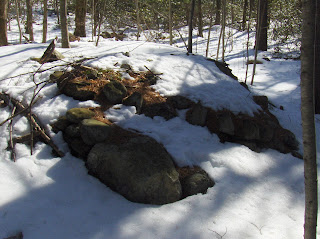But all and all, I think I'll keep the location of this mound to myself. It is pristine. You won't have trouble finding it if you look carefully. I saw this several years ago and thought the mound was only a few inches high - ignoring the obvious fact that it was sitting atop a larger artificial mound. Coming across it again, I took another look and saw that this is pretty much a typical "mound with hollow", except it is not rectangular and the hollow is not obvious.
In the past, I was struck by the sense of a ramp climbing up the side of the pile.
A magnificent example.
In the past when I looked at this pile, I did not see anything nearby. Isolated piles lack context. But this time I noticed three things nearby. One was a small rock-on-rock, which I did not photo. But I was happily surprised to see something else in the bushes down at the water's edge. Never saw this before because I never came in winter:
Another view:
This is a perfect little smeared crescent - just like the ones in Groton between Horse Hill and Blood Rd. I always thought these were an older form of "mound with hollow". So now the larger mound has some context.
I also noticed that the stone wall had an opening in it, next to the larger mound.
In overview, here is the mound with a wall running straight back from the large rock in the foreground. The lake is to the left.
It is fair to say that this is a lake shore culture.








2 comments :
Perhaps one might say it is a lake shore component of the larger Ethnographic Cultural Landscape (that includes other diverse zones)...
I think of the older things as being closer to the water's edge. There is a faint correlation between amount of smear and type of view - with the older things looking out over an open space created by water and marsh; while the later things are looking out over open space created by drop-off of the hill they are on.
It is just an impression I have but I would like to quantify it better.
Post a Comment